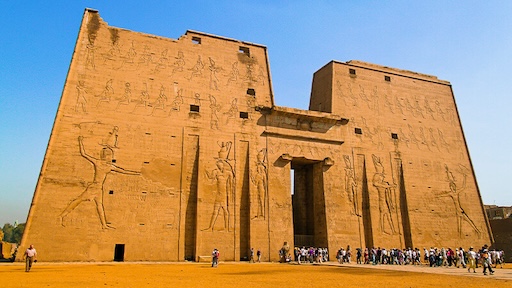
If you’ve ever wanted to step into a perfectly preserved piece of ancient Egypt, the Temple of Edfu is as close as it gets. Dedicated to Horus—the falcon-headed god of kingship and the sky—this towering sandstone monument is one of the most complete temples to survive from antiquity. It’s big, bold, and brimming with stories carved into every wall.
Built for the Gods, Preserved by Sand
Construction of the Temple of Edfu began in 237 BCE under Ptolemy III and took nearly two centuries to complete. As time marched on, layers of sand and debris slowly buried the temple, preserving it like a time capsule until it was rediscovered in the 19th century. When excavated, its walls emerged nearly intact—detailed, towering, and deeply cinematic.
A Falcon’s Eye View of Power
Walk through the first pylon and you’re greeted by towering images of Horus vanquishing evil. Inside, massive columns rise like stone papyrus stalks, and hieroglyphs tell tales of divine battles, rituals, and cosmic order. One of the most impressive sights? The statue of Horus himself, carved in black granite and guarding the entrance like a sentinel frozen in time.
The Sacred Drama of Good vs Evil
Much of the temple’s artwork chronicles the eternal battle between Horus and his nemesis, Seth. Every wall seems to echo this divine drama: Horus triumphing over chaos to restore ma’at, the ancient Egyptian concept of harmony and justice. These carvings weren’t just decorative—they were ceremonial scripts, used in temple rituals to reenact and reaffirm the divine balance.
Hidden Chambers and Celestial Ceilings
The deeper you go, the quieter and darker it gets. In the sanctuary, you’ll find the sacred barque shrine where Horus’s statue once rested. Overhead, ceilings still hold faint traces of blue and gold stars, mirroring the heavens above. There are also secret rooms and chapels, once used by priests to store ritual items and prepare for sacred ceremonies.
Modern-Day Adventure to an Ancient Site
Reaching Edfu is part of the fun. Most travelers arrive via Nile cruise, docking at the town of Edfu and taking a horse-drawn carriage—or caleche—to the temple gates. The ride feels like time travel, clattering through dusty streets until the looming pylon of the temple rises into view.
Tips for Travelers
- Visit in the morning to beat the heat and the crowds.
- Bring a guidebook or guide. The stories in the carvings are rich with myth and meaning.
- Wear comfy shoes—this temple is large and worth exploring thoroughly.
- Don’t miss the Nilometer—an ancient tool for measuring the Nile’s flooding.
Falcon’s Pride, Timeless Power
The Temple of Edfu isn’t just a monument—it’s a message from the past, a statement of cosmic order etched in stone. As you walk through its echoing halls and sunlit courtyards, you’re not just seeing history—you’re feeling it, in the shadows, in the silence, in the gaze of Horus himself.
And when you step back outside and look up at the towering pylon, it’s easy to believe that the falcon still watches over Egypt, wings spread wide, guarding a land of wonders.
Share this story and inspire others.
Tags: Temple of Edfu, Horus Temple, Edfu Egypt, ancient Egyptian temples, Ptolemaic architecture, Horus statue, hieroglyphics, Nile River temples, Edfu sanctuary, falcon god Horus, sacred barque, temple restoration, Egypt travel, Edfu tourism, ancient Egypt sites
 Dendera Temple Complex: Where Stars, Myths, and Stone Align
Dendera Temple Complex: Where Stars, Myths, and Stone Align
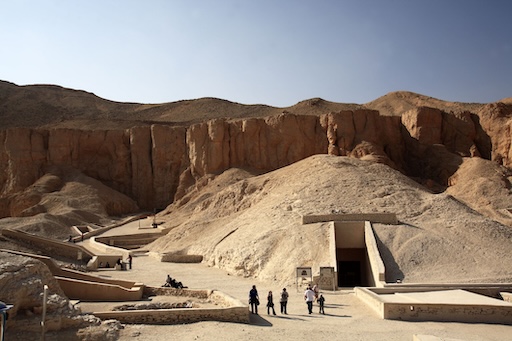 Valley of the Kings: The Eternal Resting Place of Pharaohs
Valley of the Kings: The Eternal Resting Place of Pharaohs
 Abu Simbel Temples: Monuments That Moved Mountains
Abu Simbel Temples: Monuments That Moved Mountains
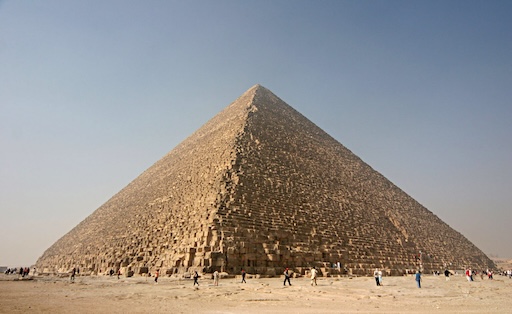 The Great Pyramids of Giza: Alien Relics or Eternal Engineering?
The Great Pyramids of Giza: Alien Relics or Eternal Engineering?
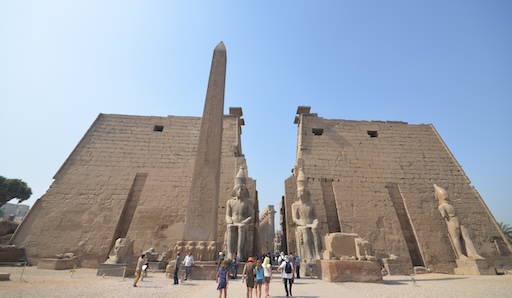 Luxor Temple: A Stage for Gods and Kings
Luxor Temple: A Stage for Gods and Kings
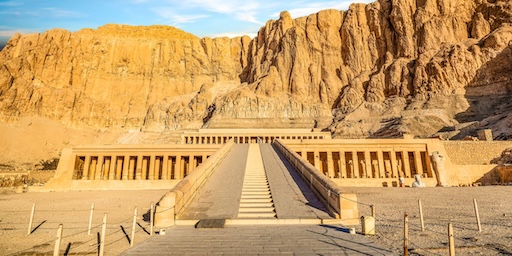 Temple of Hatshepsut: Egypt’s Queen of Stone
Temple of Hatshepsut: Egypt’s Queen of Stone